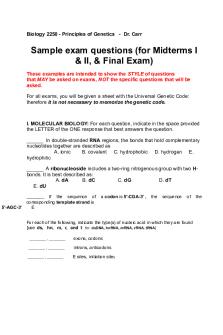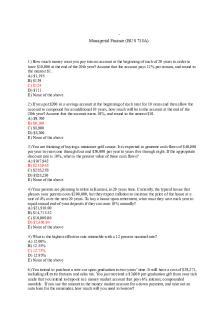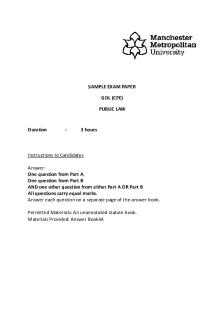Metrology Exam questions PDF

| Title | Metrology Exam questions |
|---|---|
| Course | Metrology |
| Institution | Loughborough University |
| Pages | 8 |
| File Size | 362.7 KB |
| File Type | |
| Total Views | 155 |
Summary
Download Metrology Exam questions PDF
Description
METROLOGY (16MMC603) Summer 2017
2 Hours Answer ALL questions. Any approved University calculator is permitted.
1.
Uncertainty Analysis is a key part of Metrology. An aerospace component destined for Boeing Corporation in the USA, is manufactured by Moog Ltd in Wolverhampton (UK). One dimension of the component is measured a number of times by one operator using a Mitutoyo micrometer. A second dimension is measured using a Mitutoyo Vernier Caliper by another operator. Both sets of results are recorded in inches and are shown in Table Q1(A) and Table Q1(B) respectively. A statement of equipment specification is provided by Mitutoyo, and is defined as being (±0.0035 inches at a 95% confidence level) for the Micrometer, and (±0.020 inches) for the Vernier Caliper. Student t-distribution coefficients are identified in Table Q1(C). a)
b)
c)
d)
In brief terms, explain why Uncertainty Analysis is important for a measurement process, and identify the primary international standard or framework that underpins Uncertainty Analysis.
[4 marks]
When completing an Uncertainty Analysis for a measurement process, briefly identify eight elements of the measurement process that may cause uncertainty within the final measurement result, and explain what the initial pragmatic approach should be to further assessment of these sources.
[8 marks]
Using diagrams where appropriate, detail the manner in which individual Uncertainties are processed and subsequently combined into a final Expanded Uncertainty statement (U). Reference should be made to appropriate data manipulations that are required, and assumptions made about the probability distributions of the uncertainty sources.
[5 marks]
Calculate the Expanded Uncertainty value (U) for the two measured dimensions defined above, and state your assumptions made for these two different scenarios. [8 marks] Page 1 of 8 /continued
2.
Coordinate Measuring Machines (CMM) use Touch Trigger Probes to determine data points in Cartesian and/or Polar Coordinates. Like any measurement instrument (simple or complex) application can be made more efficient by the use of Inspection Planning. The National Physical Laboratory have published four Measurement Good Practice Guides concerned with application and use of CMMs, including; CMM Probing, and, Inspection Planning for CMMs. a)
b)
Briefly identify the key elements of a generic Dimensional Inspection Plan, specifically in the context of a CMM, taking into account the requirements from; switching the CMM on, through to data processing.
[4 marks]
A series of geometric shapes that exemplify typical measurements completed using a CMM are shown in Figure Q2(A). Define the minimum mathematical requirements for probing these features, and, estimate alternative requirements for probing these features, justifying why your answers may be different to the mathematical minimum. [6 marks]
A component is shown in Figure Q2(B) that is required to be measured using a Hexagon Metrology Global Advantage 775 CMM, using a Renishaw PH10MQ Probe Head, with a medium force TP20 TTP. Appropriate Renishaw styli are shown and can be selected from Table Q2(A) and Table Q2(B) using the Renishaw part numbers where relevant. The MPEE statement for the CMM is (1.4 + L/450 μm), and the A, B and C component datums are aligned with the X, Y, Z global coordinate system and axes of the CMM respectively. c)
Develop and detail a brief Dimensional Inspection Plan using the CMM for the component shown in Figure Q2(B), specifically taking into account all features that are labeled (V, W, X, Y and Z respectively). Identify what are the measurement issues when dealing with the measurement of the ensemble of features, what appropriate styli should be chosen using Tables Q2(A) and/or Q2(B), and what additional equipment you might need to cause successful measurement of these features. [7 marks]
d)
Measurement data from the component is shown in Table Q2(C) for a limited number of the component features. Process the data and identify the status of each feature with respect to the specification, noting that object orientation may have changed as a function of measurement requirement. Note that reference to the MPEE statement should be made where relevant. Page 2 of 8
[8 marks] /continued
3.
Many R surface texture parameters exist for surface roughness measurement. One such parameter is known as the “arithmetic mean of the absolute departures of the profile from the mean line”. a)
b)
Using diagrams where appropriate, explain how this parameter is derived, and how it may be manually calculated from a profile trace. In addition, identify what additional information is required to supplement the parameter value to allow confidence in understanding and use of the final result, and why this parameter may lead to ambiguity when measuring different types of surface.
[8 marks]
Two other similar variants of this parameter exist and are described using the capital letters P and W. Explain what the differences are between P, R and W based parameters for this specific example, in what circumstances they may be applied, and how the information they generate should be interpreted.
[4 marks]
c)
Figure Q3 shows a section of a trace profile that has been recorded from an object surface using a Form Talysurf Intra with a 50 mm long stylus and a stylus tip with a radius of 0.5 μm. The object is manufactured from magnesium alloy. Calculate the approximate value of the primary quantifier of the “arithmetic mean of the absolute departures of the profile from the mean line”, for the trace shown in Figure Q3. A section spacing of approximately 2 μm would be appropriate. [9 marks]
d)
The object has been measured at a temperature of 299 K. With respect to the vertical direction and the mean line through the trace, identify how much the peaks and valleys would change if thermal compensation was applied with reference to the International Temperature for Measurement, and identify what influence this would have on the previously calculated “arithmetic mean of the absolute departures of the profile from the mean line” value. [4 marks]
Magnesium alloy properties: Elastic Modulus; 45x109 Nm-2, Shear Modulus; 17x109 Nm-2, Coefficient of Thermal Expansion; 24.8x10-6 K-1, Poisson Ratio; 0.290. J N Petzing
Page 3 of 8
/continued
1.375 1.378 1.377 1.374 1.373 1.376 1.375 1.378
1.372 1.376 1.377 1.375 1.375 1.378 1.374 1.373
1.374 1.376 1.373 1.375 1.377 1.374 1.375 1.372
Table Q1(A)
4.21 4.25 4.19 4.17 4.20
4.18 4.23 4.20 4.21 4.19 Table Q1(B)
Data Points (n) 3 4 5 6 7 8 9 10 11 12 13 14 15 16 17 18 19 20
(k = 1) 1.32 1.20 1.14 1.11 1.09 1.08 1.07 1.06 1.05 1.05 1.04 1.04 1.04 1.03 1.03 1.03 1.03 1.03
Student t-factor (k = 2) (k = 3) 2.27 --1.66 3.07 1.44 2.21 1.33 1.84 1.26 1.63 1.22 1.51 1.19 1.43 1.16 1.36 1.14 1.32 1.13 1.28 1.12 1.25 1.11 1.23 1.10 1.21 1.09 1.20 1.09 1.18 1.08 1.17 1.08 1.16 1.07 1.15
Table Q1(C)
Page 4 of 8
/continued
Ruby ball / Tungsten Carbide stem Ball diameter mm
0.5
0.7
1.0
1.5
2.0
2.5
3.0
4.0
5.0
Length 10 mm
A-50007805
A-50007801
A-50031325
–
–
–
–
–
–
20 mm
A-50031345
A-50030577
–
A-50030034
A-50033822
A-50031896
A-50030938
A-50031029
A-50030046
30 mm
–
–
A-50008663
A-50030035
A-50030036
A-50030038
A-50030040
A-50030043
A-50030047
40 mm
–
–
–
–
A-50030037
A-50030039
A-50030041
A-50030044
A-50030048
50 mm
–
–
–
–
–
–
A-50030042
A-50030045
A-50030049
Table Q2(A)
Ruby ball / Carbon Fibre stem Ball diameter mm
4.0
5.0
6.0
Length 30 mm
A-50034241
A-50034781
A-50034782
50 mm
A-50032285
A-50032286
A-50032287
75 mm
A-50034784
A-50034785
A-50034786
100 mm
A-50032289
A-50032290
A-50032291
Table Q2(B)
Feature X
Feature Y
(61.00, 42.097, 4.002) (49.003, 42.102, 3.998) (61.014, 23.108, 4.001) (48.994, 23.084, 4.003) (47.507, 36.614, 4.000) (47.510, 28.598, 4.002) (66.512, 36.603, 3.999) (66.511, 28.598, 3.997) (70.414, 15.001, -10.497) (84.408, 15.002, -10.501) (77.393, 15.000, -3.488) (77.421, 15.002, -17.504) (70.409, 56.999, -10.503) (84.402, 57.001, -10.493) (77.413, 57.000, -3.472) (77.394, 56.998, -17.494) Table Q2(C)
Page 5 of 8
/continued
Figure Q2(A)
Page 6 of 8
/continued
Figure Q2(B) Page 7 of 8
/continued
Figure Q3
Page 8 of 8...
Similar Free PDFs

Metrology Exam questions
- 8 Pages

MCQ - Unit 1 Metrology
- 10 Pages

Exam, questions
- 1 Pages

Exam Questions
- 9 Pages

Exam, questions
- 7 Pages

Exam, questions
- 9 Pages

Exam, questions
- 62 Pages

Exam, questions
- 8 Pages

Exam, questions
- 5 Pages

Exam, questions
- 5 Pages

Exam, questions
- 2 Pages

Exam, questions
- 10 Pages

Exam, questions
- 2 Pages

Exam, questions
- 24 Pages

EXAM, questions
- 6 Pages
Popular Institutions
- Tinajero National High School - Annex
- Politeknik Caltex Riau
- Yokohama City University
- SGT University
- University of Al-Qadisiyah
- Divine Word College of Vigan
- Techniek College Rotterdam
- Universidade de Santiago
- Universiti Teknologi MARA Cawangan Johor Kampus Pasir Gudang
- Poltekkes Kemenkes Yogyakarta
- Baguio City National High School
- Colegio san marcos
- preparatoria uno
- Centro de Bachillerato Tecnológico Industrial y de Servicios No. 107
- Dalian Maritime University
- Quang Trung Secondary School
- Colegio Tecnológico en Informática
- Corporación Regional de Educación Superior
- Grupo CEDVA
- Dar Al Uloom University
- Centro de Estudios Preuniversitarios de la Universidad Nacional de Ingeniería
- 上智大学
- Aakash International School, Nuna Majara
- San Felipe Neri Catholic School
- Kang Chiao International School - New Taipei City
- Misamis Occidental National High School
- Institución Educativa Escuela Normal Juan Ladrilleros
- Kolehiyo ng Pantukan
- Batanes State College
- Instituto Continental
- Sekolah Menengah Kejuruan Kesehatan Kaltara (Tarakan)
- Colegio de La Inmaculada Concepcion - Cebu
